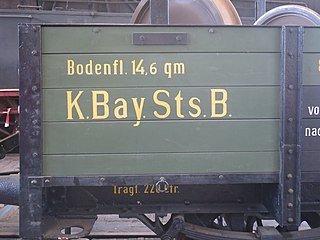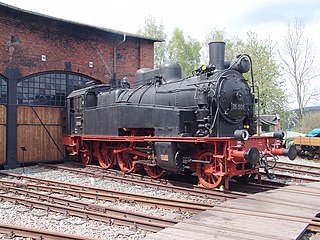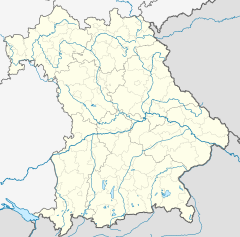
The Eisenbahnmuseum Bochum-Dahlhausen is a railway museum situated south of the city of Bochum in the state of North Rhine-Westphalia, Germany. It was founded by DGEG, the German Railway History Company in 1977 and is based in a locomotive depot that was built between 1916 and 1918 and ceased operation in 1969. Then DGEG took over the whole area of 46,000 square metres and built up the biggest railway museum in Germany. In the middle of the museum, there is an engine shed with fourteen tracks. A preserved turntable, coaling, watering, and sanding facilities are still in operation. This museum is integrated into The Industrial Heritage Trail a route of monuments from the history of the industry.

The Royal Bavarian State Railways was the state railway company for the Kingdom of Bavaria. It was founded in 1844. The organisation grew into the second largest of the German state railways with a railway network of 8,526 kilometres by the end of the First World War.

The Class PtL 2/2 locomotives of the Royal Bavarian State Railways were light and very compact superheated steam locomotives for operation on Bavarian branch lines. There were three types in total, of which two were transferred to the Deutsche Reichsbahn-Gesellschaft as Class 98.3 tank locomotives and even survived to join the Deutsche Bundesbahn fleet after the Second World War.

The DBK Historic Railway is a preserved railway association in Crailsheim, Germany.

The Prussian Class P 8 of the Prussian state railways was a 4-6-0 steam locomotive built from 1906 to 1923 by the Berliner Maschinenbau and twelve other German factories. The design was created by Robert Garbe. It was intended as a successor to the Prussian P 6, which was regarded as unsatisfactory.

The Bavarian Class Gt 2×4/4 engine of the Royal Bavarian State Railways, was a heavy goods train tank locomotive of the Mallet type. It was later designated the DRG Class 96 by the DRG, DB and DR.

The Darmstadt-Kranichstein Railway Museum is a railway museum in the German city of Darmstadt. It is also the largest railway museum in the state of Hesse.

The Class 80 tank engines were German standard locomotives (Einheitsloks) with the Deutsche Reichsbahn. They were intended to replace the aging, rickety state railway line engines performing shunting duties in their dotage at large stations.

The Neustadt/Weinstrasse Railway Museum is one of the two railway museums run by the German Railway History Company, or DGEG. It is located in the station at Neustadt an der Weinstraße. The other one is the Bochum Dahlhausen Railway Museum.

The Dampfbahn Fränkische Schweiz e. V. or DFS is a German museum railway operated by a registered society in Ebermannstadt, in a region of northern Bavaria, Germany, known as Franconian Switzerland.

The Prussian T 18 was the last class of tank locomotives developed for the Prussian state railways. They were originally intended for services on the island of Rügen as replacements for Class T 12 and T 10 engines. They emerged when a class of locomotive was conceived in 1912 that was to handle express and passenger trains in border areas or in shuttle services on short routes. A tank engine design with symmetrical running gear was envisaged because, unlike a tender locomotive, it could run equally fast forwards and backwards and could be operated on return journeys without having to be turned on a turntable. Its power and top speed were to be the same as those of the P 8. Robert Garbe designed this 4-6-4 (2′C2′) tank locomotive for 100 km/h with a 17-ton axle load and contracted the Vulkan Werke in Stettin to build it. It was given the designation T 18.

The South German Railway Museum is a railway museum at Heilbronn in the state of Baden-Württemberg in southwestern Germany. It was founded in 1998.

The Schiefe Ebene is a steep incline on Bamberg–Hof section of the Ludwig South-North Railway in the region of Upper Franconia, in Bavaria, Germany.

The German DRG Class 95 are ten-coupled tank locomotives with a 2-10-2 wheel arrangement, which were procured by the Deutsche Reichsbahn in 1922 for hauling heavy goods trains on steep main lines. Because the development of this class was started by the Prussian state railways, it was designated as the Prussian Class T 20.

The steam locomotives of Class 23 were German passenger train locomotives developed in the 1950s for the Deutsche Bundesbahn. They had a 2-6-2 wheel arrangement and were equipped with Class 2'2' T 31 tenders. They were designed to replace the once ubiquitous Prussian P 8 engines that had been built between 1908 and 1924 and, in their day, were the most numerous post-war replacement class.

The Saxon Class XIV T locomotives were six-coupled tank engines operated by the Royal Saxon State Railways for mixed duties on main and branch lines. In 1925, the Deutsche Reichsbahn grouped them into their DRG Class 75.5.

The Prussian Class T 14.1 was a German 2-8-2T, goods train, tank locomotive operated by the Prussian state railways and the Royal Württemberg State Railways. They were later incorporated by the Deutsche Reichsbahn into the DRG renumbering plan for steam locomotives as DRG Class 93.5–12.

The Spessart Ramp is a 5.4 km long incline on the Main-Spessart Railway in southern Germany between Laufach at one end and the Schwarzkopf tunnel and Heigenbrücken at the other, with an average incline of 20 ‰. The ramp is part of Ludwig's Western Railway and the section from Würzburg via Aschaffenburg to the state border at Kahl am Main was opened on 1 October 1854 by the Royal Bavarian State Railways. The ramp enabled the difference in height between the Laufach valley and the Lohr valley to be overcome as it crossed the Spessart between Kahl am Main and Aschaffenburg on the one side and Würzburg/Bamberg on the other.



































